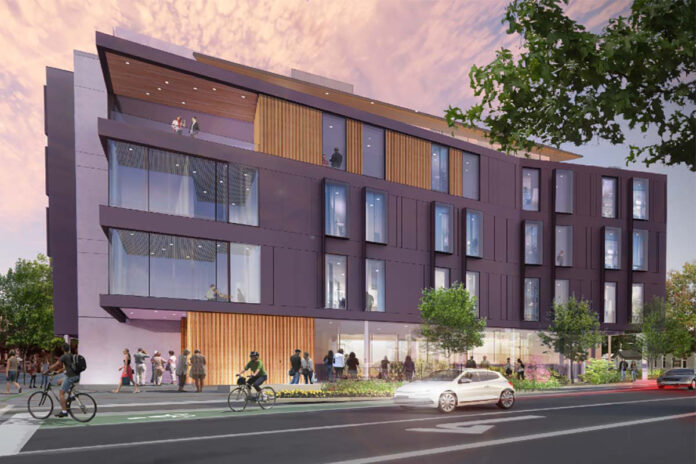
The University of Victoria (UVic) is teaming up with Royal Roads University (RRU) and Camosun College to build a collaborative university campus on Vancouver Island in Langford, B.C.
A $98-million project, a five-storey timber facility, will accommodate up to 1,300 students in Greater Victoria’s West Shore—one of Canada’s fastest growing regions—who would otherwise take long and often difficult commutes to access their post-secondary education.
“I bicycle from downtown Victoria to Royal Roads and that’s 15 kilometres with big hills,” Richard Kool, an RRU School of Environment and Sustainability professor and RRU Faculty Association president, said.
“We don’t have many big highways here, so there’s a lot of people travelling on two-lane roads to get into the city. Morning traffic is really bad. Buses go slow, cars go slow.”
Kool explained accessing Greater Victoria communities located farther west, where the roads become windy, already makes for a long journey.
RRU’s president and vice-chancellor, Philip Steenkamp, said high school graduates from West Shore communities participate less in post-secondary education around Greater Victoria than those who live in the more centralized City of Victoria.
“The participation rate in post-secondary education out here is [also] lower than the provincial average,” Steenkamp added.
He noted the rate of people in the West Shore who immediately pursue post-secondary studies after high school falls at least 10 per cent lower than the provincial average of 53 per cent. Overall, West Shore high school graduates are half as likely to attend post-secondary education as average B.C. high school graduates.
“What we don’t want to see is students on the highways, driving their vehicles. We want to be able to see people get education in the places they live.”
“It’s actually an environmental issue for us,” said Geoff Wilmshurst, vice-president of Camosun’s Partnerships division. “What we don’t want to see is students on the highways, driving their vehicles. We want to be able to see people get education in the places they live.”
To start building the campus, UVic, RRU and Camosun had to submit a business proposal to the provincial government. Steenkamp described the process as involving “a lot of Zoom meetings” with Coast Salish peoples living in the project area, as well as meetings with architects and municipal and provincial government officials to present their proposal and discuss blueprints.
The three institutions received $1.5 million in provincial funding for planning the project and on Aug. 2 received full permission to construct the campus. The provincial government contributed $77.8 million for campus construction, while RRU pitched in $18.5 million to purchase the land.
From the City of Langford, the institutions have another $30 million in funding and a commitment to providing $375,000 over five years for high school graduates wishing to attend the campus. According to Langford Mayor Stew Young, this brings the total value of the project to $125 million.
“That’s the single biggest investment in [the span of] Langford’s history that we have to date, and it’s [in] education,” Young said at an announcement for the campus this summer. “That is very fitting because everybody said here [that education] is a really important part of all of our communities in the West Shore.”
Steenkamp said RRU, as the property owner, will take charge of managing the campus. UVic and Camosun, along with the Justice Institute of British Columbia (JIBC) in the Lower Mainland, will offer additional programs on the campus and operate as tenants.
“We also have the local school district, which is [School District 62], which also wants to offer some programming there,” Steenkamp said. “I think over time we will invite other institutions who might be interested.”
He said that though UVic, RRU and Camosun are relying partly on the province’s job data to determine the programs they offer on campus, the interests of prospective students in the area will also play a part in determining what they teach. Steenkamp added they did a lot of survey work prior to submitting the proposal.
“We [the institutions] surveyed communities, families out here, including the students,” he said. “We went into the high schools to talk to students. We spoke to high school counselors … about what they were hearing from students. We did a series of what we call ‘pop-up universities,’ just to test the market a little just to see what the students were interested in.”
Wilmshurst noted the most in-demand sectors for learning are health care, early childhood care and technology. According to a B.C. government release, UVic will offer computer science, engineering and humanities courses, Camosun will provide educational and health-care assistant training and JIBC will supply paramedic and first-responder training.
“I think [the West Shore campus] will expand opportunities for people and perhaps open up a climate of greater collaboration for the institutions involved.”
Kool said when it comes to fostering the social atmosphere of the campus, such as with clubs and societies, he hopes students can develop these sub-organizations on their own as one body, rather than three.
“I think [the West Shore campus] will expand opportunities for people and perhaps open up a climate of greater collaboration for the institutions involved,” he said in an email. “It might even attract students from elsewhere to live here.”
Construction of the campus is scheduled to begin sometime this September. The campus is expected to officially open Sept. 1, 2024, and immediately serve roughly 600 students.
In an earlier version of this article, Richard Kool was identified as RRU’s faculty of social and applied sciences president, rather than faculty association president. Ownership of the campus was also incorrectly stated as being shared by UVic, RRU and Camosun, rather than solely possessed by RRU. The Charlatan regrets the errors.
Featured image by BoForm and provided by hcma.





